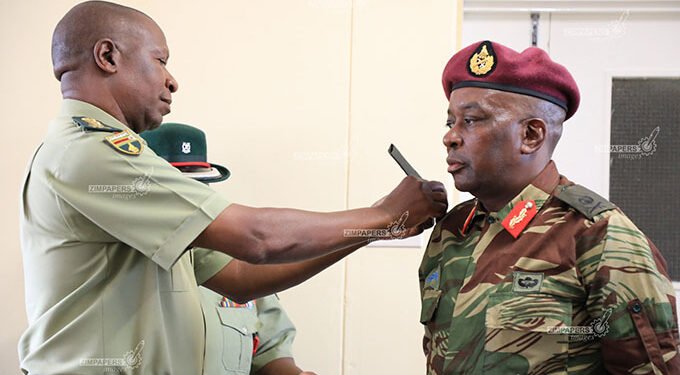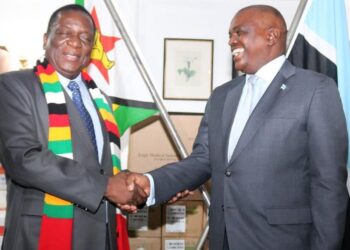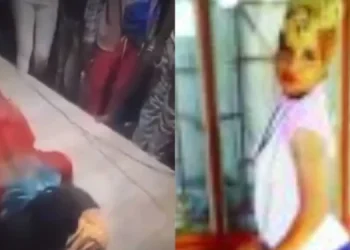AS President Emmerson Mnangagwa continues to make surprise post-election appointments amid political manoeuvres by the military to reposition itself for a more influential role going forward, Zimbabwe’s Military Intelligence Directorate (MID) commander Major-General Thomas Moyo is set to be redeployed, security sources say.
The changes in the army reflect a fightback by the military, which installed Mnangagwa in power following a coup in November 2017, after it was recently sidelined from politics, including the elections. Zimbabwe’s politics is militarised.
The sources said Moyo, who is related to Air Marshal Elson Moyo and the late Foreign Affairs minister Retired Lieutenant-General Sibusiso Moyo, is likely to be posted to Kinshasa, Democratic Republic of Congo (DRC), to replace the late Johannes Tomana or deployed to Minsk, Belarus.
“More changes in the army are coming,” a security source said.
“The MID commander Tom Moyo is likely to be redeployed and sent to DRC. Some say he might be going to Belarus. DRC is open after Tomana’s death in August. Belarus might be tricky because a new ambassador, Graham Mudzimba, was appointed in July, coming from Cuba/Guyana.”
Sources said there are still going to be new changes in the military in line with post-election politics.
“More changes are coming in the army. The changes are mainly driven by the military, something which Mnangagwa can’t resist,” the source said.
This comes soon after shock changes within the Zimbabwe Defence Forces (ZDF) led by General Philip Valerio Sibanda.
Mnangagwa, who promoted five colonels, including a woman, to become brigadier-generals a few days ago, last week appointed Sibanda an ex officio member of Zanu PF’s decision-making administrative organ, politburo, a move widely criticised as unconstitutional and unlawful.
Before that, Mnangagwa had recently redeployed former ambassador to Tanzania retired Lieutenant-General Anselem Sanyatwe to be the new Zimbabwe National Army (ZNA) commander.
He replaced the retired General David Sigauke who had taken over from the late Lieutenant-General Edzai Chimonyo in 2021. Sanyatwe is a close ally of Vice-President Constantino Chiwenga, a retired general.
“Whether Moyo is going to DRC or Belarus, Sanyatwe will be replaced by Police Commissioner-General Godwin Matanga. Deputy Commissioner-General Stephen Mutamba will then take over the police,” the source said.
“If Sibanda, who was not happy with Sanyatwe’s appointment, ends up quitting to join politics fulltime, then it would be interesting to see who becomes the ZDF commander. Will they quickly promote Sanyatwe again to take over that role or bring back someone like retired Lieutenant-General Engelbert Rugeje, whom Mnangagwa does not want and blocked from replacing Chimonyo as ZNA commander? If Sanyatwe goes up again, who takes over the ZNA? Perhaps Major-General Hlanganani Dube. Such changes can only happen if Chiwenga has regained control. These sort of changes would signify a military manoeuvre and a strong bouncing back, meaning Mnangagwa will be on his way out.”
These changes are happening amidst speculation Mnangagwa wants a third term of office.
When Mnangagwa and his military allies seize power through a coup in November 2017, there was a deal on how to share the spoils of victory over the late former president Robert Mugabe, although a fight broke soon after that.
The deal collapsed after Mnangagwa reneged on serving one term and leaving power to Chiwenga.
This has caused political tensions between the two, which sometimes explode into the open. The political war of attrition between Mnangagwa and Chiwenga most prominently found expression in the President’s controversial 2021 biography as internecine unresolved leadership issues linger on.
Former independent Norton MP Temba Mliswa previously said Mnangagwa’s former adviser Chris Mutsvangwa, now War Veterans minister, has been plotting to remove Chiwenga from his position.
Mutsvangwa was recorded by Chimonyo discussing the issue. Mnangagwa and Chiwenga are fighting over the spoils of the November 2017 military coup.
Chiwenga, who engineered the coup and put Mnangagwa in power, thought the President would serve only one term and hand over the reins of power to him in 2023, but that has been publicly rejected, fuelling tensions and hostilities.
Ezoic
Chiwenga feels betrayed. Mnangagwa’s authorised biography titled A Life of Sacrifice: Emmerson Mnangagwa exposes the rift between the two.
The 154-paged biography, which Mnangagwa described as a “brief window” into his life, was authored by Eddie Cross, a former opposition MDC high-ranking official and MP who became the President’s adviser.
It depicts Chiwenga in negative light through its narrative. Cross, Mnangagwa’s biographer and new loyalist, said the President will brook no nonsense from those threatening his hold on power, a warning to Chiwenga.
Mnangagwa, who at the time of the coup had fled the country to South Africa after his mentor-cum-tormentor Mugabe had hounded him, only returned after Chiwenga led the coup that ended the late dictator’s 37 years in power.
Mugabe later described Mnangagwa as his “tormentor”. The book reveals that Chiwenga’s appointment as co-deputy, together with Kembo Mohadi, was part of Mnangagwa’s coup-proofing ploy.
Ezoic
Mnangagwa appointed Sibanda to succeed Chiwenga as ZDF commander as he saw him as loyal, although the army’s project remains intact.
Sibanda, according to the book, is “possibly the best soldier in southern Africa and a man that was deeply respected in the army”, which brings into focus Mnangagwa’s decision to appoint him an ex-officio member of the Zanu PF politburo.
“Mnangagwa’s actions drew little attention, but what the President was doing was closing the door on any possibility of the military assisted transition (military coup) being repeated. He needed to know that the security services were led by men in whom he had confidence as professionals,” the book says.
Differences between Mnangagwa and Chiwenga played out when the latter demanded that a state of emergency — Martial Law — be declared during the 2019 riots which had been triggered by a 150% increase in the price of fuel.
“When it became known that a state visit to Russia was planned for the week beginning the 14th January 2019, disturbing intelligence was received that disturbances were planned,” the book reads.
Ezoic
“The President consulted his security chiefs about the threat and gave instructions about what was to happen in his absence…The acting President retired General Chiwenga, demanded that a state of emergency be declared and that Martial Law be introduced. This would have effectively meant that the armed forces took over the administration of the state and the commander-in-chief of security services, but General Sibanda refused. He said his orders from the President were very clear.”
This suggested a new rift between Chiwenga and Sibanda, although insiders say it was only a question of timing and strategy, not rivalry.
Internet services were suspended during the protests after security forces were deployed to quell the disturbances.
The coup deal between the coup-plotters was: Oust Mugabe, then install Mnangagwa and Chiwenga, then ZDF commander, and Mohadi as co-vice-presidents.
Mnangagwa was to be the political and civilian face of the coup to avoid a backlash from the Southern African Development Community, African Union and the international community, including the United Nations.
Ezoic
Chiwenga was the military architect of the coup. He was at the centre of the planning and execution of the putsch, whose strong roots go back to 2008 when the army rescued Mugabe after he had lost to the late main opposition MDC-T leader Morgan Tsvangirai. Mugabe told journalists in interviews in March 2018 at his Blue Roof Borrowdale mansion in Harare that Chiwenga was the architect.
Mnangagwa, with Chiwenga as the point man, engineered a contrived run-off between Mugabe and Tsvangirai when the opposition leader had actually won the presidential poll outright to save Mugabe.
The MDC-T defeated Zanu PF by one parliamentary seat in the March 2008 elections. Security sources say soon after the 2008 election fiasco for Mugabe and Zanu PF, and the army’s subsequent intervention, Mnangagwa and Chiwenga effectively took control.
After rescuing Mugabe, their only stumbling block was retired army commander General Solomon Mujuru who had managed to leverage his power and influence as a kingmaker to impose his wife Joice as vice-president at a Zanu PF congress at Sheraton Hotel (now Rainbow Towers) in Harare in December 2004.
This followed Mnangagwa’s Tsholotsho Declaration fiasco, which triggered purges within the party. Mujuru and his faction defeated Mnangagwa’s group and took over control in December 2004 after congress.
Their influence was hugely felt and manifested itself two years later at Zanu PF’s annual conference in Goromonzi in 2006 where leadership succession undertones grew louder.
Things went off the rails in 2007 when Mujuru, strongly supported by the late Dumiso Dabengwa, forced an extraordinary congress in December 2007 ahead of the 2008 elections after a dispute over Mugabe’s candidature which played out in the politburo for months that year.
When Mugabe shrugged off Mujuru’s challenge in 2007, the former Zanla and ZNA commander plotted “bhora musango” (internal sabotage) — whose manifestation through centrifugal forces was the ead political actor Simba Makoni and his Dawn/Mavambo/Kusile project underwritten by Mujuru.
After the 2008 elections and the subsequent Government of National Unity which lasted from 2008 to 2013, Mujuru’s star started waning, although his wife remained vice-president. Mujuru remained a hindrance to Mnangagwa and Chiwenga’s coup project.
After heightened internal strife, Mujuru died in a mysterious fire on 15 August 2011. Three years later, his wife Joice was kicked out as vice-president in a military operation executed through party structures in the form of recalls and dissolution of structures.
Mnangagwa came in to replace her. Phelekezela Mphoko was appointed by Mugabe another vice-president from nowhere in 2014 to replace John Nkomo who had died the previous year.
From 2014, Mnangagwa and Chiwenga started planning how to remove Mugabe as his succession battle intensified. Efforts to get comment on Moyo’s looming redeployment were unsuccessful.











